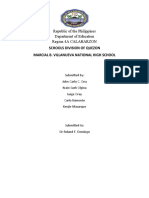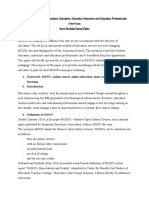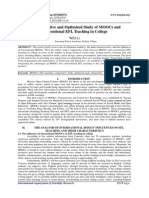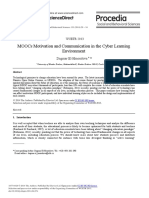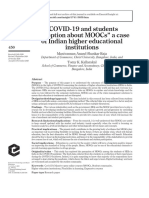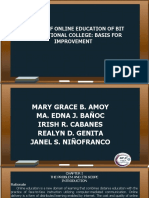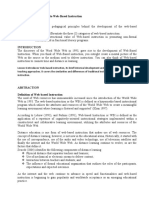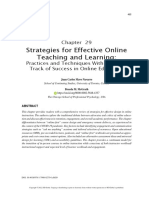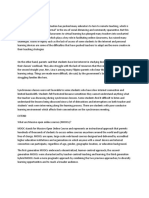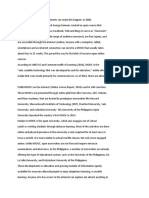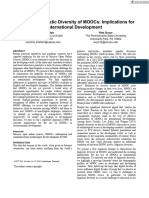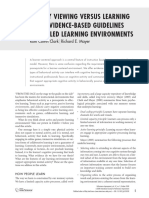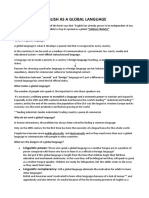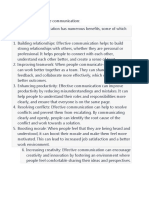Massive Open Online Courses (INFOGRAPHICS)
Massive Open Online Courses (INFOGRAPHICS)
Uploaded by
Roshelle ArizaCopyright:
Available Formats
Massive Open Online Courses (INFOGRAPHICS)
Massive Open Online Courses (INFOGRAPHICS)
Uploaded by
Roshelle ArizaOriginal Title
Copyright
Available Formats
Share this document
Did you find this document useful?
Is this content inappropriate?
Copyright:
Available Formats
Massive Open Online Courses (INFOGRAPHICS)
Massive Open Online Courses (INFOGRAPHICS)
Uploaded by
Roshelle ArizaCopyright:
Available Formats
MASSIVE OPEN
ONLINE COURSES
Beginning with the first correspondence courses in the 1890s
from Columbia University, distance learning has been an
important means of making higher education available to the
masses. As technology has evolved, so has distance learning;
and in just the last 5 years a new form of education has
arisen, Massive Open Online Courses (MOOCs).
This new set-up of educational
collaboration has made possible for
teachers and students to meet and
learn new things together without
being physically present. Hence, the
concept of Massive Open Online
Courses (MOOCs) are born.
As technology has evolved, so has
distance learning. It began with
mailing books and syllabi to
students, then radio lectures, then
tv courses, and now online courses.
Massive Open Online Course, a term
used to describe web technologies
that have enabled educators to
create virtual classrooms of
thousands of students.
ONTARIO’S DISTANCE EDUCATION AND TRAINING
NETWORK IN 2016 REPORTED THAT MOOCS HAS
INFLUENCE TEACHING AND LEARNING.
Ontario’s Distance Education and Training Network
in 2016 reported that MOOCs have influenced
teaching and learning. According to them, there are
five ways in which MOOCs are currently having an
impact on teaching and learning:
◼ Encouraging and enabling unbundling – the
separation of design, development, deployment,
delivery, and support for learning.
◼ Changing the nature of credit granting and
credentials.
◼ Supporting and accelerating the development of
blended learning.
◼ Supporting the development of learning
portfolios.
◼ Demonstrating the power of learning
communities and peer tutoring
MOOC AS AN EXTENSION
OF EXISTING
online learning approaches, in
terms of open access to courses
and scalability. The massification of
courses has generated significant
interest from governments,
institutions, and commercial
organizations.
You might also like
- Developing Instructional GuidesDocument15 pagesDeveloping Instructional GuidesRea Rose Salise100% (1)
- Do's and Don'Ts of Teaching PracticesDocument6 pagesDo's and Don'Ts of Teaching Practiceskashi100% (5)
- Five Ways Mooc Influencing Teaching and Learning: S AreDocument11 pagesFive Ways Mooc Influencing Teaching and Learning: S AreChristine Mae SamsonNo ratings yet
- MIL Moduke 9Document18 pagesMIL Moduke 9bir.email013No ratings yet
- Communication Patterns in Massively Open Online CoursesDocument9 pagesCommunication Patterns in Massively Open Online CoursesTung NghiaNo ratings yet
- Social Sciences & Humanities Open: Noura AlhazzaniDocument6 pagesSocial Sciences & Humanities Open: Noura AlhazzaniPaddy Nji KilyNo ratings yet
- WR Mil.Document4 pagesWR Mil.Aldrin EjurangoNo ratings yet
- W2 MoocDocument5 pagesW2 MoocjherzelbunanaNo ratings yet
- U1 6 MoocDocument10 pagesU1 6 MoocAnaBereniceNo ratings yet
- Bongobondhu Journal of EducationDocument65 pagesBongobondhu Journal of EducationNurul Mostafa Kamal ZafariNo ratings yet
- Navigating MOOCs For Teachers, Educators, Instructors and Education Professonals A Brief StudyDocument13 pagesNavigating MOOCs For Teachers, Educators, Instructors and Education Professonals A Brief StudyNurul Mostafa Kamal ZafariNo ratings yet
- A Comparative and Optimized Study of Moocs and Conventional Efl Teaching in CollegeDocument4 pagesA Comparative and Optimized Study of Moocs and Conventional Efl Teaching in CollegeIOSRJEN : hard copy, certificates, Call for Papers 2013, publishing of journalNo ratings yet
- ProposalDocument11 pagesProposalblessedgeraldie78No ratings yet
- Research Report-MoocsDocument10 pagesResearch Report-Moocsapi-279969612No ratings yet
- Research Report-MoocsDocument10 pagesResearch Report-Moocsapi-279969612No ratings yet
- Polygon Party (Autograph) 2 MergedDocument108 pagesPolygon Party (Autograph) 2 MergedShubham BhandariNo ratings yet
- Moocs in Higher Education: Opportunities and Challenges: Yu LiDocument8 pagesMoocs in Higher Education: Opportunities and Challenges: Yu LiNoah LeeNo ratings yet
- Impact of Moocs On Indian Higher Education: Executive SummaryDocument14 pagesImpact of Moocs On Indian Higher Education: Executive Summaryswapnil parasharNo ratings yet
- Salmon Et Al. - 2015 - Experiential Online Development For Educators TheDocument13 pagesSalmon Et Al. - 2015 - Experiential Online Development For Educators Thelamine mbengueNo ratings yet
- Cche 690 Statement PaperDocument7 pagesCche 690 Statement Paperapi-355398513No ratings yet
- Moocs anecampusMohitGuptaDocument8 pagesMoocs anecampusMohitGuptaLibrary KVMLDI0% (1)
- Online Assignment 1Document14 pagesOnline Assignment 1HAFIFAH BINTI KUSIN MoeNo ratings yet
- Exsa Smith Statement PaperDocument12 pagesExsa Smith Statement Paperapi-353916248No ratings yet
- Massive Open Online Course (MOOC)Document7 pagesMassive Open Online Course (MOOC)Miko GarciaNo ratings yet
- MOOC Script FinalDocument5 pagesMOOC Script FinalSelina WangNo ratings yet
- Open and Distance Learning inDocument11 pagesOpen and Distance Learning inHossam ElkontNo ratings yet
- Sciencedirect: Moocs Motivation and Communication in The Cyber Learning EnvironmentDocument6 pagesSciencedirect: Moocs Motivation and Communication in The Cyber Learning Environmentthaislari613No ratings yet
- Lesson 2 MoocDocument3 pagesLesson 2 MoockenjesvllNo ratings yet
- Creativity and Critique in Online Learning: Exploring and Examining Innovations in Online PedagogyFrom EverandCreativity and Critique in Online Learning: Exploring and Examining Innovations in Online PedagogyNo ratings yet
- Massive Open Online CourseDocument6 pagesMassive Open Online CourseJeremieh Cabanting CabotageNo ratings yet
- E LearningDocument20 pagesE LearningamarillonoexpectaNo ratings yet
- MOOCDocument3 pagesMOOCapen4258No ratings yet
- MOOC Notes and ActivityDocument4 pagesMOOC Notes and ActivityyasukaellahNo ratings yet
- COVID-19 and StudentsDocument25 pagesCOVID-19 and StudentsRitam chaturvediNo ratings yet
- 7 Things You Should Know About MOOCsDocument2 pages7 Things You Should Know About MOOCsJuanFranciscoLoboNo ratings yet
- Week 3 The Impact of Massive Open Online Courses MOOCsDocument16 pagesWeek 3 The Impact of Massive Open Online Courses MOOCspalomo.kizzle.sorianoNo ratings yet
- Online Education: What You Need To Know: By: Christine Marie MañusDocument30 pagesOnline Education: What You Need To Know: By: Christine Marie MañusTintin MNo ratings yet
- Quality of Online EducationDocument23 pagesQuality of Online EducationMa Edna J. BañocNo ratings yet
- Lesson 6 Introduction To Web-Based Instruction Learning OutcomesDocument4 pagesLesson 6 Introduction To Web-Based Instruction Learning OutcomesChristine Joy Marcel100% (1)
- EN Paper 20 July 26 July 2019Document40 pagesEN Paper 20 July 26 July 2019M KumarNo ratings yet
- The Use of Moocs As A Potential Avenue To Modernize Learning in The PhilippinesDocument19 pagesThe Use of Moocs As A Potential Avenue To Modernize Learning in The PhilippinesJohn LloydNo ratings yet
- Research On Online LearningDocument5 pagesResearch On Online LearningSHARMA VISHAL RAKESH 1923236100% (1)
- Employment NewsDocument40 pagesEmployment NewsVinod100% (1)
- Different Online Learning Platforms Utilized by Grade 11 STEM Students and It's Impact On Their Academic Performance.Document22 pagesDifferent Online Learning Platforms Utilized by Grade 11 STEM Students and It's Impact On Their Academic Performance.Eggs en' StonesNo ratings yet
- Strategies For Effective Online TeachingDocument16 pagesStrategies For Effective Online TeachingMunisa SaydullayevaNo ratings yet
- A Systematic Mapping Study of The EmpiricalDocument19 pagesA Systematic Mapping Study of The EmpiricalimranNo ratings yet
- Exploring Educational Platforms and Community Behavior To Support - 2016Document7 pagesExploring Educational Platforms and Community Behavior To Support - 2016archtofaNo ratings yet
- How Can Universities Adapt During COVID-19?: A Guide For Universities To Build and Scale Online Learning ProgramsDocument7 pagesHow Can Universities Adapt During COVID-19?: A Guide For Universities To Build and Scale Online Learning ProgramsMisko DzidrovNo ratings yet
- (Toledo and Seabra) - A Brazilian Web Platform For Developing Massive Online Open CoursesDocument6 pages(Toledo and Seabra) - A Brazilian Web Platform For Developing Massive Online Open CoursesMaico XuriNo ratings yet
- Lesson 6Document4 pagesLesson 6bryle abbah depedroNo ratings yet
- Literature Review On ElearningDocument12 pagesLiterature Review On ElearningFatokun Emmanuel OluwasegunNo ratings yet
- TTL 27Document5 pagesTTL 27Loberiano GeraldNo ratings yet
- 2Document2 pages2KO MINo ratings yet
- The 4 Characteristics of MoocsDocument2 pagesThe 4 Characteristics of MoocsJil More Esteban100% (1)
- MOOC Massive Open Online Course OverviewDocument32 pagesMOOC Massive Open Online Course OverviewputeraadamNo ratings yet
- Factors Extraction of Effective Teaching-Learning in Online and Conventional ClassroomsDocument6 pagesFactors Extraction of Effective Teaching-Learning in Online and Conventional ClassroomsNicollesNo ratings yet
- While Countries Are at Different Points at The Contagion Rates of The COVIDDocument6 pagesWhile Countries Are at Different Points at The Contagion Rates of The COVIDChoudhrywalidNo ratings yet
- Mooc Statement PaperDocument7 pagesMooc Statement Paperapi-390034752No ratings yet
- The World Wide Web - A Technology To Enhance Teaching and LearningDocument10 pagesThe World Wide Web - A Technology To Enhance Teaching and Learninglucaseggen66No ratings yet
- A Guide To Quality in Online LearningDocument28 pagesA Guide To Quality in Online LearningPedro MoralesNo ratings yet
- Education Online The Latest State of ResearchDocument54 pagesEducation Online The Latest State of ResearchHalina Ostańkowicz-Bazan100% (1)
- Proceedings of The Association For Information Science and Technology - 2016 - StrattonDocument10 pagesProceedings of The Association For Information Science and Technology - 2016 - StrattonMohammedNo ratings yet
- Learning How To Be Polite Through A MovieDocument8 pagesLearning How To Be Polite Through A MovieThúy Duyên PhạmNo ratings yet
- Megan Redmond ResumeDocument2 pagesMegan Redmond Resumeapi-253469786No ratings yet
- Freaky Weasel Marketing PlanDocument14 pagesFreaky Weasel Marketing PlanAndrew RogersNo ratings yet
- Perception of Teachers' Towards Extensive Utilization of Information and Communication TechnologyDocument13 pagesPerception of Teachers' Towards Extensive Utilization of Information and Communication TechnologyJenny TiaNo ratings yet
- The Aussie Accent Facts and Common IdiomsDocument3 pagesThe Aussie Accent Facts and Common IdiomsDenisa PascuNo ratings yet
- Differences Between Direct Method and Grammar Translation MethodDocument1 pageDifferences Between Direct Method and Grammar Translation MethodSaddam Hossain75% (4)
- Complexities of Identity FormationDocument29 pagesComplexities of Identity FormationPhạm TàiNo ratings yet
- 4° Classroom LanguageDocument4 pages4° Classroom Languagesnake6919No ratings yet
- 5G Core Network Product InformationDocument49 pages5G Core Network Product InformationIPLOOK Technologies100% (1)
- Reflection: Session 1 Mandate, Vision, Mission, Core Values, and Strategic DirectionDocument17 pagesReflection: Session 1 Mandate, Vision, Mission, Core Values, and Strategic DirectionJessa DongaNo ratings yet
- Fundamentals of Marketing Sylabus 2022 - 2 Oct.10th 2022Document6 pagesFundamentals of Marketing Sylabus 2022 - 2 Oct.10th 2022sofiaNo ratings yet
- Interview QuestionsDocument2 pagesInterview QuestionsHimanshu MaanNo ratings yet
- Roche Resume - InternetDocument2 pagesRoche Resume - Internetapi-281411012No ratings yet
- Linkedin Presentation 1Document9 pagesLinkedin Presentation 1api-484770351No ratings yet
- Learning by Viewing Versus Learning by Doing - Clark MayerDocument9 pagesLearning by Viewing Versus Learning by Doing - Clark MayeravarvareNo ratings yet
- English As A Global LanguageDocument2 pagesEnglish As A Global LanguageAMAL CERULLINo ratings yet
- Nse-3 Fortivoice Q&A: Question TextDocument11 pagesNse-3 Fortivoice Q&A: Question Textgurunge67% (3)
- Sayyed Abrar Akhtar 1 Academic WritingDocument15 pagesSayyed Abrar Akhtar 1 Academic WritingAmeer ul Mominin100% (1)
- Purcom ReviewerDocument4 pagesPurcom ReviewerJudyann SisterCabauatanNo ratings yet
- Myp Years 4-5 Grade 9-10 RubricsDocument33 pagesMyp Years 4-5 Grade 9-10 Rubricsapi-299831303No ratings yet
- TOS Reading and Writing 3RD QTRDocument3 pagesTOS Reading and Writing 3RD QTRCathelynNo ratings yet
- 173653Document3 pages173653Yeroham DawitNo ratings yet
- Gamification and Cross Over Learning A Way To Improve The Speaking Skills of Students in EnglishDocument14 pagesGamification and Cross Over Learning A Way To Improve The Speaking Skills of Students in EnglishMariter PidoNo ratings yet
- 13.feature Usage Card - FLPDocument3 pages13.feature Usage Card - FLPManikandan SubramanianNo ratings yet
- Lesson 4a Multimodal TextsDocument7 pagesLesson 4a Multimodal Textslheamaecayabyab4No ratings yet
- Report in The Conduct of Dry-Run On Learning Delivery ModalitiesDocument3 pagesReport in The Conduct of Dry-Run On Learning Delivery ModalitiesRames Ely GJNo ratings yet
- Husnain CommunicationDocument7 pagesHusnain CommunicationMr USamaNo ratings yet
- Promotion Mix/ Marketing Communication MixDocument31 pagesPromotion Mix/ Marketing Communication Mixritam chakrabortyNo ratings yet






